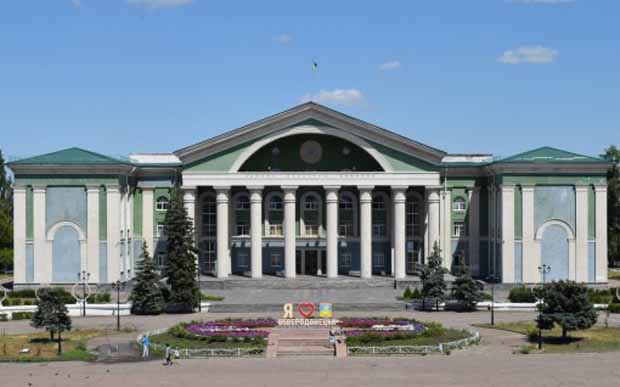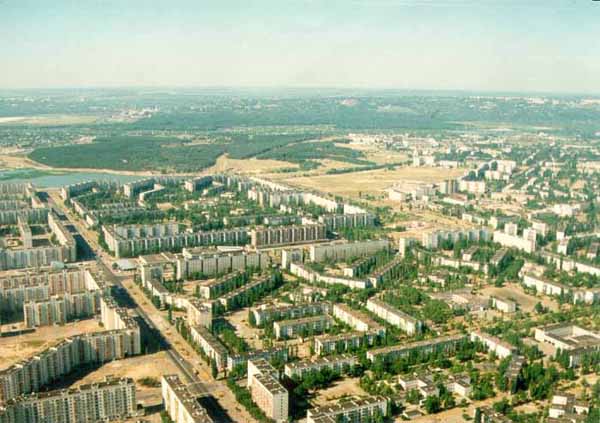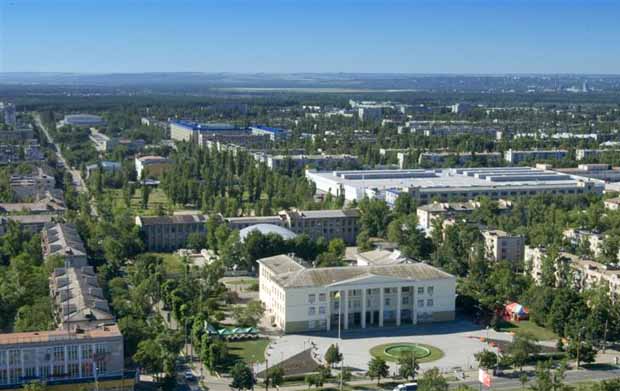Sievierodonetsk
Sievierodonetsk [Сєвєродонецьк; Sievierodonec'k], the official name (a transliteration from the Russian, Северодонецк; Severodonetsk), but arguably Siverskodonetsk [Сіверськодонецьк; Sivers'kodonec'k] (etymologically proper conflation of a city from the name of the river, the Siverskyi Donets River). Map: V-19, DB Map: DBII-4. A city (2020 pop 102,400) on the left bank of the Donets River in Luhansk oblast. It is the largest center of chemical industry in Ukraine. The population of Greater Sievierodonetsk (the Sievierodonetsk City Council, which includes 4 towns southeast of the city, Borivske [5,700], Metiolkine [800], Syrotyne [1,600], and Voronove [800]) in 2020 was 111,300. Together with Greater Lysychansk (109,900) to the southwest and Rubizhne (56,800) to its immediate north, it forms an elongated conurbation of 287,000. Since the occupation of Luhansk by pro-Russian forces in 2014, Sievierodonetsk serves as the provisional Ukrainian administrative center of Luhansk oblast. There is a domestic airport 6 km southeast of the city.
History. The settlement was founded in 1934 as Lyskhimbud (the Lysychansk Chemical Builers’) settlement during the construction (beginning in 1937) of a nitrogen-fertilizer manufacturing complex on the northern wooded terrace across the Donets River from Lysychansk. Its population in 1939 was 5,000. During the Second World War, after some factory equipment was evacuated, Liskhimbud was occupied by German troops on July 11, 1942 and liberated by the Red Army on February 1, 1943. Work to restore and expand the Lysychansk Nitrogen Fertilizer Plant began on December 10, 1943. Equipment from 6 German chemical factories (taken as war reparations) was installed. Prisoners of war were employed; by 1946, the prewar housing stock was completely restored. In 1950 the settlement was renamed Sievierodonetsk (other names proposed were: Svitlohrad, Komsomolsk-na-Dontsi, and Mendeleevsk); in 1958 it was granted city status. The city’s population grew as more industrial enterprises were built and production expanded: 1959 (33,200), 1970 (90,000), 1979 (113,000), 1989 (131,000). With economic stagnation and then demographic aging, the growth of the city slowed down by 1991 to 133,000, peaked during Ukraine’s independence in 1993–94 (135,000) while experiencing an economic crisis, and then began to decline: 1995 (133,000), 1998 (129,000), 2001 (120,000). The ethnic composition of Greater Sievierodonetsk population (130,000) in 2001 was as follows: Ukrainians, 59.0 percent; Russians, 38.7 percent; Belarusians, 0.6 percent; others, 1.7 percent. As a result of a prolongued process of Russification of the region, the Russian language had taken root. Among self-declared Ukrainians, 53.2 percent identified Russian as their native tongue; among self-declared Russians, only 1.7 percent identified Ukrainian as their native tongue; among self-declared Belarusians, 83.6 percent identified Russian, 4.5 percent identified Ukrainian, and only 11.9 percent retained Belarusian as their native tongue. In the early 2000s the economy stabilized; struggling state enterprises were either privatized or went bankrupt, while the service sector expanded.
Following the Orange Revolution and the victory of Viktor Yushchenko in the 2004 presidential elections, disgruntled supporters of his rival Viktor Yanukovych convened a congress in Sievierodonetsk (28 November 2004), where they proposed to form the ‘South-East Ukrainian Autonomous Republic’ and seek help from the Russian Federation. That move was peacefully resolved, but served as a precedent for the partial occupation of the Donets Basin in 2014.
Following the Euromaidan Revolution, in early May 2014 the city administration yielded to the pro-Russian separatist militants of the so-called ‘Luhansk People’s Republic’ (LPR). The militants prevented Ukrainian presidential elections from taking place in the city, severed access to Ukrainian media, and terrorized pro-Ukrainian residents. On 22 July 2014, Ukrainian forces, commanded by Colonel Oleksandr Radiievsky (later killed in an ambush), liberated the city from the LPR militants. In September 2014 the Luhansk oblast administration moved from the LPR-controlled Luhansk to Sievierodonetsk. Young volunteers assisted refugees in Luhansk oblast (since May 2014) and formed a charitable organization, ‘Vostok-SOS’ (Spring 2015) with offices in Kyiv and Sievierodonetsk, to support them. A bridge across the Donets River, damaged during the war in 2014, was re-opened in December 2016 with financial aid from the European Union.
Economy. Sievierodonetsk is the largest center of chemical industry in Ukraine; it accounts for 22 percent by value of all industrial output in Luhansk oblast. It is the home of two giant chemical firms: 1) the Azot Corporation (established in 1951, producer of nitrogen fertilizer, methanol, acetic acid, vinyl acetate and its derivatives, and other chemical products [becoming one of the largest in Europe and the largest in the USSR], acquired in 2004 by White World Chemical, USA, then by Ostchem [Dmytro Firtash group] in 2011, suspended operations in 2014, resumed operations in 2020); and 2) the Skloplastyk Corporation Plexiglas-maker (first in the USSR, given priority as a Komsomol project; production began in 1961, privatized in 1994, partnered with the Austrian Florhof Handels und Beteiligungs Gmbh since 2003).
Other enterprises include: the Sievierodonetsk Orgkhim (established in 1960 as a union of engineers designing and bringing into production chemical plants throughout the USSR, it became a closed joint-stock company in 1996 with contracts abroad); the UkrKhimEnerho (a public joint-stock corporation, building boilers for chemical industry); the Sievierodonetsk plant of chemical unstandardized equipment (established in 1966, producer of equipment for oil, chemical, petrochemical, gas, and metallurgical industries, and power-generating plants); the Sievierodonetsk Research and Production Association ‘Impulse’ (established in 1956 as a branch of the Moscow Special Design Engineering Bureau, subordinated in 1958 to the Kyiv Automation Institute, became a leading maker of computers, control and management systems for industry and transport, now a private shareholding company); and the Rizikon scientific center for risk assessment (established in 1991, provides research into operations of enterprises and assesses industrial and labor safety).
The Sievierodonetsk Thermal-electric Power Station (since 1952, coal-fired, with its 3 blocks completed in 1955, 1963, and 1966 respectively, converted to natural gas in 1980), provides electricity (260 MW capacity) and heat (906 Gcal/hr capacity) to the Azot plant and the city.
Since the fall of the Soviet Union a number of large enterprises were closed: the Sievierodonetsk Chemical-Metallurgical Plant; the Luhanskkhimbud construction complex; the Sievierodonetsk Resistor Plant (electronic component-maker); the Enerhokhimremont repair works; a silicate brick plant; and the Sievierodonetsk city dairy. Enterprises that were opened include the Anteks-Avtomatica LLC (established in 1997, designers and makers of gas analyzers, spectrophotometers, and other equipment), Himexelen LLC (established in 2004, makers of polyurethane products), the Microtherm LLC circuit-breaker makers, and the Ukrainian-Polish Wiko-Ukraine LLC (established in 2000, maker of shelving, checkout counters, wire-mesh equipment). Continuing to serve the city are a bakery, building-materials (cement, brick, ceramics), construction, and woodworking enterprises.
Culture and education. In the Soviet period cultural and educational institutions in the city focussed primarily on support for industrial development. Until 1993 Sievierodonetsk hosted the Scientific Research Institute of Safety Technology in Chemical Industry, the Sievierodonetsk Chemical-Mechanical Tekhnikum, 8 vocational-technical schools (including a builders’ school), and an industrial museum.
After Ukraine’s independence, some vocational-technical schools were consolidated, while direction turned to retraining and personnel management. Thus the Sievierodonetsk Higher Vocational Technical School (established as a tekhnikum in 1944) was combined with another technical school in 1997, expanded to include bookkeeping and computing in 2000, and absorbed two more technical schools in 2009. The Sievierodonetsk Institute for Raising Qualifications, Retraining and Training Cadres (established in 1967 as a branch of a Moscow-based institute for retraining cadres in chemical industry) became an independent entity in 1992 and then part of the Ukrainian Ministry of Labor and Social Policy in 1995. The Sievierodonetsk Institute of the Interregional Academy of Personnel Management was established in 1997 as a Branch of the Interregional Academy of Personnel Management (est. 1989 in Kyiv), and granted an institute status in 2006. Humanities received higher priority. The Sievierodonetsk Children’s School of Fine Arts (established in 1970) gained higher profile, and the Sievierodonetsk Sergei Prokofiev College of Culture and Arts (established as a school of music in 1966, named after Sergei Prokofiev in 1976) was accredited as a postsecondary college in 2008. The National University of Kyiv-Mohyla Academy established its college school—a Ukrainian-language preparatory school—in Sievierodonetsk in 1996; two others followed: the Sievierodonetsk multiprofile lyceum in 1997 and the Sievierodonetsk humanitarian-aesthetic gymnasium in 1999.
As a result of hostilities in 2014, Sievierodonetsk gained two universities whose faculty fled from Luhansk: the Luhansk State University of Internal Affairs (established in Luhansk in 1993, evacuated in its entirety in 2014 to Sievierodonetsk), and the Eastern Ukrainian National University (split in 2014 between two head offices: one in the Ukraine-controlled Sieverodonetsk, and the other in the LPR-controlled Luhansk, where it was re-named the V. Dahl Luhansk National University).
Sports and physical education were well developed with facilities better than average. Each school was endowed with a gym, a pool, and a sports field. Pride in place belonged to the Ice Sports Palace, built in 1975 (the largest covered arena in Luhansk oblast and one of the largest in Ukraine); until 1985 it was used for ice hockey and figure skating; from 1986 to 2005 as a concert hall (renovated for the convention in Sievierodonetsk by the supporters of Viktor Yanukovych) with a capacity of 5,000 spectators; from 2005 to 2014 as a volleyball court (home of the ‘Sievierodonchanka’ women’s volleyball team, champion of Ukraine in 2009), and since then as a facility for the Youth Sports School No. 4. There are: the Tennis Palace with three indoor tennis courts (built in 1959, used for national and USSR-wide championships), two stadiums (‘Khimik,’ home of the Azot Corporation employees’ football club ‘Khimik’ [contested for the championship of the USSR in 1960–73 and of Ukraine, first league, in 1992–98], and ‘Budivelnyk,’ several sports complexes, swimming pools (the ‘Sadko’ is specialized for underwater orienteering, another for platform diving), gyms, and shooting ranges. Five youth sports schools are associated with most of these facilities.
Education and culture are supported by 49 libraries, of which 7 were public, 22 associated with schools, 9 technical, 2 of trade unions and 1 medical; a fine arts gallery; and 5 museums (at Azot [1974] and Impulse enterprises, at the Center for Tourism and Excursions [2004], and a doll museum [2004] and regional studies museum [2009] of the Center for Child and Youth Creativity).
Sievierodonetsk has two palaces of culture. The City Palace of Culture (built in 1963 as the Builders’ Palace of Culture, since 1992 acquired by the city) hosts a score of groups, including the dance ensemble ‘Evryka’, the choir ‘Kozachi naspivy,’ the choir ‘Nadiia,’ the ensemble of popular songs ‘Luch,’ the ensemble of ballroom dancing ‘Mriia,’ and a theater. The Chemists’ Palace of Culture (built 1956–67, privatized by Azot Corporation in 2005) hosts its own or other artistic performance groups by invitation.
Before 2014 Sievierodonetsk had three theater groups: the Sievierodonetsk City Drama Theater, the City Palace of Culture Drama Theater, and the Chemists’ Palace of Culture Youth Drama Theater. Following the hostilities in 2014, two cultural institutions arrived from Luhansk: the Luhansk Ukrainian Academic Music and Drama Theater, which then absorbed the Sievierodonetsk City Drama Theater, and the Luhansk Oblast Philharmonic Orchestra (including the Academic Symphony Orchestra, the ‘Radany’ Song and Dance Ensemble, and a popular music group ‘Bez Mezh’). The city has about 12 irregular or weekly publications. The city council’s bilingual weekly is Sievierodonets'ki visti (preceded in the Soviet period by Komunistychnyi shliakh, established in 1965). There are 5 television channels available from Lysychansk and many more FM radio stations, including 5 in Sievierodonetsk.
Public practice of religion revived after 1991, following Ukraine’s independence, and places of worship were built by the faithful. The Ukrainian Orthodox Church-Moscow Patriarchate has a cathedral and two churches; the Protestants have two churches; the Orthodox Church of Ukraine has one church; the Ukrainian Catholic church has its Pastoral-Social Mission; there is an Islamic Cultural Center with its mosque; and Jehovah’s Witnesses have their meeting hall.
City plan. Sievierodonetsk is a compact, post-Second World War city. The city includes some green space around it, together forming an irregular area of 58 sq km; its built-up area of industrial, institutional, and residential land occupies only 20.8 sq km. On a map, this built-up area appears as an irregular rectangle of wide streets and avenues in a bold grid pattern, extending 7.7 km from east to west and 4.6 km from north to south. Industries occupy the western half of this built up area; the multi-story apartment buildings, parks, and public institutions form the eastern half. The industries of Sievierodonetsk are served by railway spurs collected and linked to a trunk line at Rubizhne to the northwest. The main north-south thoroughfare separating the industrial from the residential and institutional parts of the city is the Bohdan Lyshchyna Street; to the north it leads to Rubizhne; to the south, as Peace Street, it leads to the Sievierodonetsk Airport.
The industrial and residential parts of the city are connected, among others, by two main east-west arterials: the Chemists’ Avenue, leading directly to the main entrance of the Azot complex, and the Guardsmen’s Avenue, which skirts the southern perimeter of Azot, past the Sievierodonetsk Thermal Electric Power Station and the village of Pavlohrad, and then across the bridge over Donets River to Lysychansk. The northern bypass connects to Industrial Street, which follows the northern perimeter of the Azot complex and the southern side of Skloplastyk, branching off to the west as Highway R66 to Lysychansk.
Many prominent institutions of Sievierodonetsk are located in or along the wide north-south mall formed by Central Avenue. The southern anchor of the mall is the Ice Sports Palace. West of it are the Sievierodonetsk Chemical-Mechanical Tekhnikum, the Sievierodonetsk Vocational Builders’ Lyceum, and between them the Budivelnyk Stadium; a block east of it is the main city market. North of the Ice Sports Palace is a long park and water basin promenade to Victory Square. West of Victory Square is the Impulse Research and Production Association; east of the square, the Luhansk Oblast Administration. Beyond Chemists’ Avenue is the Nikolai Gogol Square and beyond it, the college school of the National University of Kyiv-Mohyla Academy and its sports field. North of this is a park, and beyond it, the Sievierodonetsk City Hall. Beyond the boulevard is Peace Square and facing it from the north, and forming the northern anchor, is the Chemists’ Palace of Culture. North of it is the Khimik Stadium and sports complexes.
Two blocks west of the city hall, on the south side of the Friendship of Nations Boulevard, is the Appellate Court of Luhansk Oblast, and on the north side, the Sievierodonetsk City Court, and, in a park-like setting with statues of Taras Shevchenko and Ivan Franko, the Luhansk Oblast Academic Ukrainian Music and Drama Theater.
City passenger transport is provided by a network of buses (since 1955, 5 routes) and trolleybuses (since 1978, expanding from 2 to 5 routes by 1985). There are also private minibuses with set routes. Intercity passengers use highway buses or trains (out of nearby Lysychansk or Rubizhne, with their stations located on the Kharkiv–Debaltseve double track trunk line); since the hostilities of 2014, the Sievierodonetsk Airport has been closed to commercial traffic.
BIBLIOGRAPHY
‘Sievierodonets'k’ in Heohrafichna entsyklopediia Ukraïny (Kyiv 1993)
‘Severodonetsk: Plan goroda’ 1:12,000 in Mista Ukraïny (Kyiv 2010)
Snehiriov, V., Martynenko, O., Movchan, S. Istoriia odnoho mista. Okupatsiia ta zvil'nennia Sievierodonets'ka (Kyiv 2017)
Karta Sievierodonetska, Luhans'koi oblasti (2020) https://kartaukrainy.com.ua/en/sieverodonetsk
Ihor Stebelsky
[This article was updated in 2021.]


